Getting high landing page conversions is the aim of every marketer. Companies want to create better user experiences that increase form sign-ups through enticing copy and design.
But is that enough?
Adding the headline, images, and video just to fill up elements on a landing page only results in poor performance. Understanding how every page element works in coherence to convert a visitor is the starting point for getting a good landing page experience.
There is no one way to create excellent landing pages. But there are initial conditions and paths that a marketer must take to beat the competition. The foundations of an effective landing page are the same. Once a brand has mastered the basics, then only it can optimise the page for further success.
But when is the right time to optimise your landing pages? By determining and analysing common landing page conversion benchmarks, it becomes easier to know when it would be right to revisit a landing page design. Let’s take a look at some of these ideas.
Conversion rate is crucial for every marketing campaign. It signifies whether the goal behind creating a campaign is achieved or not. It is essential to discuss conversion rates while talking about landing pages. Unlike websites where it is normal if the visitor just explores around and not convert, for landing pages, it is pivotal.
The sole purpose of a landing page is to convert a visitor into a lead or to take an action, e.g. click-through to another page, add a product to the cart, sign up with their email address, be it any type of landing page. It is a standalone page dedicated to a brand’s services and products, pushing the brand as a direct answer to customer queries. For a landing page to be impactful, it needs rigorous iterations of analysis.
Instead of going with gut feeling, companies must look at landing page conversions past benchmarks to know where a campaign is headed. Understanding when a landing page needs a complete overhaul or just minor tweaks saves cost, time, and effort of your team.
We have compiled a list to make it easier:
Hubspot claims the average landing page conversion for all industries is 9.7%.
According to Campaign Monitor, the average landing page conversion rate across industries is 2.35%.
Unbounce analysed sixteen different industries. From their report, we calculated the average landing page conversions to be 4.89%.
For WordStream, the average landing page conversion rate is 2.35%. It also claimed that the top 25% of landing pages have a conversion rate of 5.31%, which rises to 11.45% for the top 10% of landing pages.
Can you spot the pattern?
Because we can’t. Other than Campaign Monitor and WordStream, there is no other similar stat.
This might look confusing. If there are no benchmark landing page conversions, how should a marketer examine their pages?
The conversion rate varies throughout industries. While some have high click-through-rates and conversions, others lag. From research across industries by Unbounce, we can see in the chart below that catering & restaurant landing pages lead with an average conversion rate of 18.2% and a median of 9.8%. But the same is not valid for all other industries.
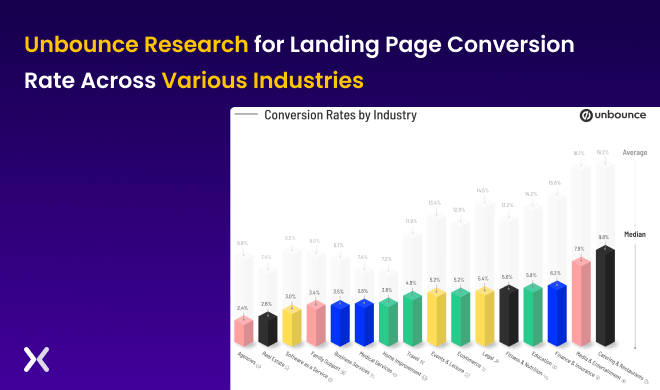
From this data, we can conclude that goal setting for landing page conversions should be set by keeping the industry in mind. Marketers must keep an eye on the average landing page conversions per industry but can always seek higher results.
The best way to set a personal landing page conversions benchmark is:
1. Identify the current conversion rate of the landing page and the elements that encourage visitors’ positive action.
2. Analyse the impact of the conversion rate on business.
3. It can result in two scenarios:
First Scenario: The conversion rate is satisfactory, which can act as the benchmark for other landing pages. In such cases, a heatmap analysis can tell about the crucial elements on the page that are pushing for conversion. It can help generate similar results.
Second Scenario: The conversion rate is below satisfactory. Here, a thorough CRO plan is required, starting with a heatmap analysis for elements creating conversion friction.
A hidden landing page element most marketers don’t talk about is:
“Value Proposition”
Not to be confused with unique selling proposition (USP), which is all about what sets a product apart from its competition. Marketers can consider the USP of a product to be a subset of the value proposition, but it’s not the whole story.
A value proposition is all about the target customer and what type of brand experience they are looking for. While a USP might vary from product to product of a brand, the value proposition remains the same. Identifying what business assistance a brand can offer its customers makes up for the value proposition.
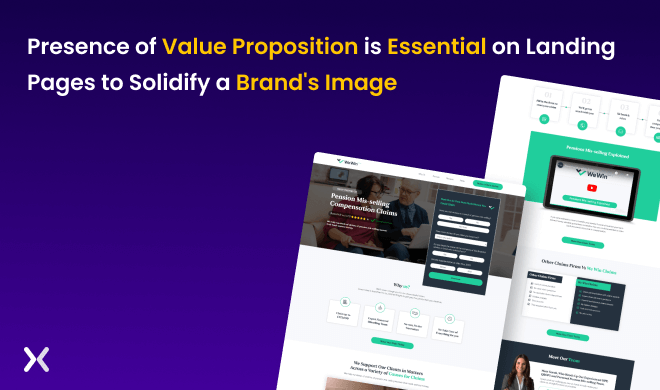
For example: A tech company delivering custom software builds products based on every customer’s personal choice. For the tech company, the value of personalised products is what it can offer consistently. So, its value proposition becomes customer experience.
But what about a SaaS company that cannot customise its product? SaaS companies provide value to their clients through impeccable operations support. Through timely updates, new features in-line with market demand, smooth SaaS experience, etc., all these combine to deliver operational excellence as a value proposition for SaaS companies.
Other excellent examples of customer experience and operational excellence are Subway and McDonald’s. Subway allows customers to pick and add the stuffings to their order representing a great customer experience. In contrast, McDonald’s keeps it simple by offering pre-made deals and focusing on operational excellence.
Marketers can identify their company’s value proposition by answering the question, “WHY should someone buy from me?”. A value proposition speaks from a company’s perspective for why someone should become their customer. It signifies the ultimate functionality a company can offer its target audience without compromise. Knowing your buyers’ personas is crucial before jumping on to find the value proposition, as it helps come up with clear answers.
The value proposition should be one of the main leverages for landing page conversions. It should have a presence at every fold of the page. The right placements of the value proposition and USP inspire visitors to scroll out of curiosity, not confusion.
To determine how to utilise the value proposition and USP to its full potential, one must understand the basic structure of a landing page.
A finance landing page can be about loans, trading courses, online banking systems, etc. When prospects visit a finance landing page, they want to see numbers and how legit the services are.
Hindering it with just text-based elements is not going to work. By using trust worthy numbers and reliable information, brands can pique visitor interest. Another thing to remember is to address users’ insecurities about investing their money before clicking the CTA and pushes for higher landing page conversions.
For example: A UK based company debunks prospects’ doubts by addressing them in highlighted bullet points right above the CTA.
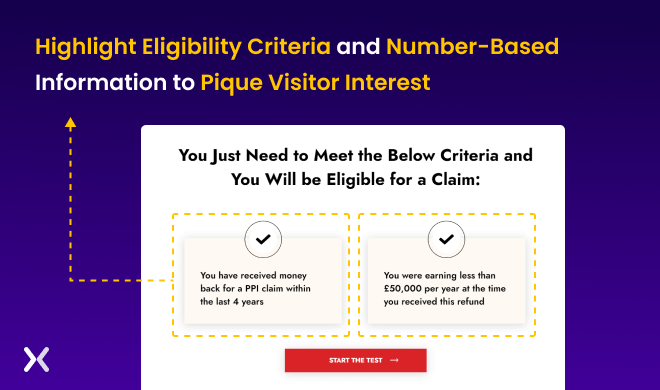
Like any other landing page, a SaaS landing page is a dedicated page built for a specific campaigns (like free trials, demo booking, subscription pages, etc.) and traffic source. The goal of every landing page is to increase the number of visitors who convert to your offer by providing a hyper-relevant experience.
But a personalised experience cannot be built with all the same elements everyone uses. What is that one thing which can make a SaaS landing page stand out?
It’s the SaaS itself.
Brands need to showcase their software in action, performing various promised tasks with ease. Be it through images, gifs, or videos, include them to increase SaaS landing page conversions.
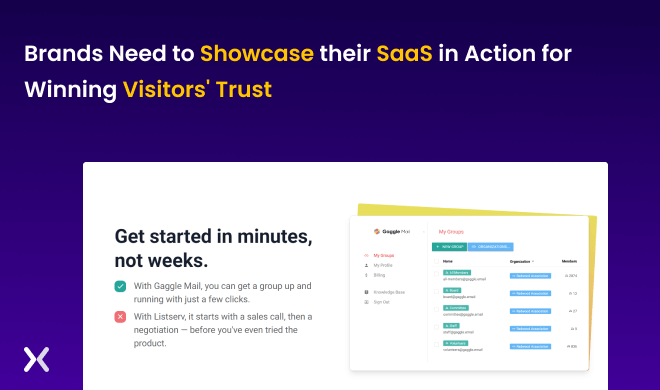
Suggested Read: B2B SaaS Marketing: The Right Landing Page Strategy For SaaS
Tech Consulting landing pages are mostly B2B related. So, it becomes essential to follow a highly professional tone throughout the landing page copy. On a consulting firm landing page, trust badges, awards, and testimonials from other company leaders become crucial.
For example: DOOR3 is a software consulting and development firm. Its landing page showcases previous won awards as trust badges. They take it up a notch by linking their Clutch profile so that visitors can access more social proof.
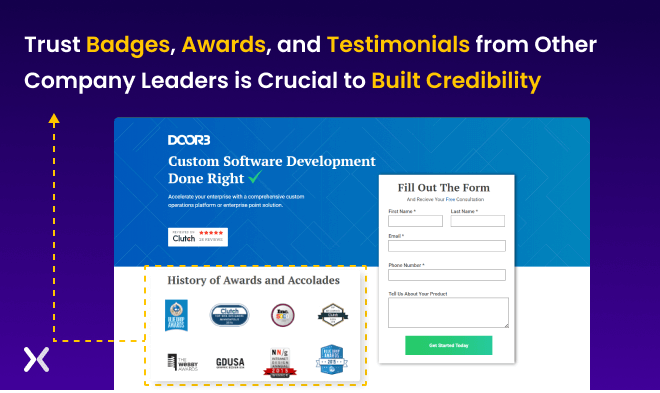
Healthcare landing pages are where users might be hesitant to share personal information. Whether mental or physical, a patient’s privacy should be the prime concern for every healthcare facility. So, a privacy policy must always be present on a healthcare landing page.
It is also crucial to add a click-to-call button to make it easier for leads to book appointments.
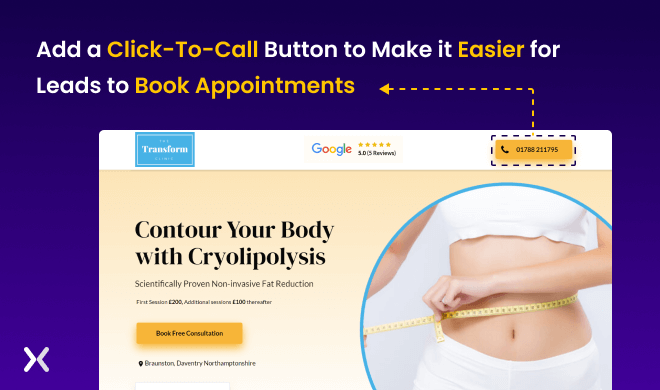
Regarding social proof, showcasing before and after results for major processes works excellently to increase landing page conversions.
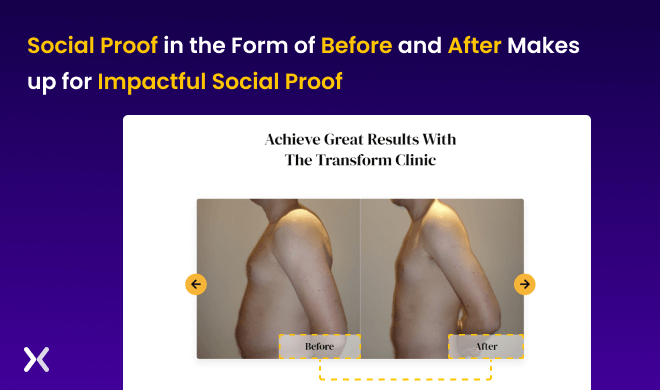
Mortgage companies need a lot of customer information before finding what type of property a prospect wants to get funded. But asking so many questions on a landing page form is not possible, making it hard to scale your lending business. To solve this issue, multi-step forms are used on a mortgage landing page to make it easier for prospects to share information.
A mortgage landing page’s copy must also include the duration and process of loan clearance. It helps prospects who need urgent approvals get the crucial info directly instead of going through long documents.
For example: Union Home Loan Inc. provides real estate loans. On its landing page, we have used a multi-step form, highlighted the loan approval period in the subhead, and further expanded it by explaining the approval process. Every element on this page helps bring in landing page conversions.
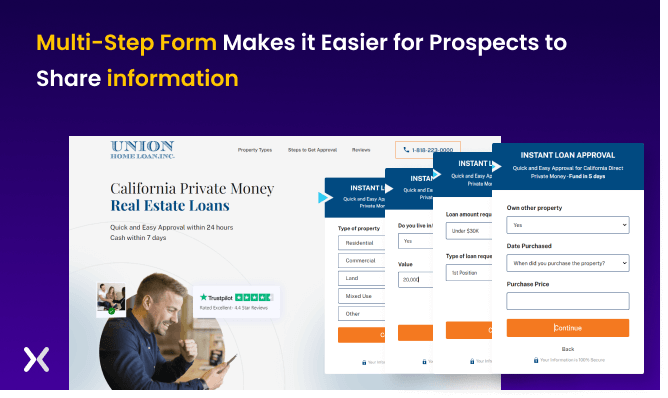
Sometimes, a company’s services are very similar to competitors. Here, the USP of a product or service helps set the brand apart. A comparison table is a great way to showcase what all a brand offers better than its competitors and increase it’s landing page conversions.
For example: Not for Profit Funeral Plans, a company that offers cremation and burial services, competes with many other companies. Realising that the price is what makes them stand out, the company has used a cost comparison chart to highlight it.
The thing to notice in this example is that Funeral Plans have added the comparison table to the hero section/ above the fold of the page. So it becomes the first thing visitors see when they enter the page, and USP gets communicated immediately.
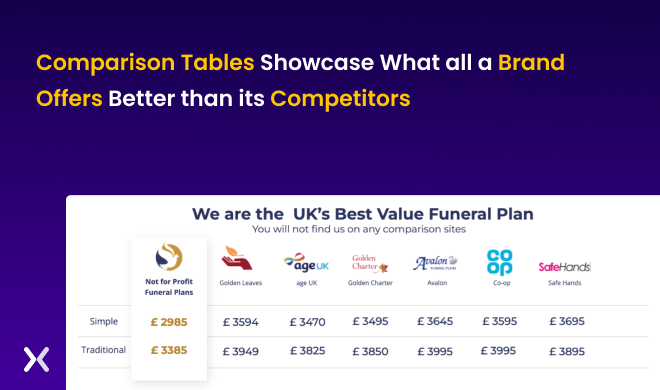
PPC landing page copies must always match the ad copy.
But marketers must also remember how to implement landing pages for the same ad groups. A Google ad group contains ads that target similar keywords. Each ad group must have its own landing page variant. But it doesn’t mean that all the PPC ads present in the same group will have identical landing pages.
For example: Below are two landing pages of the same ad group by DOOR3, a software consultant and development company. Both pages are for MS Access migration services. While the overall design of the landing page stays the same, the headline copies of the pages differ.
For the first landing page, the headline targets solution-aware prospects. It focuses on leads that are aware that their MS Excess database is weak, and migrating to MySQL is the solution. Therefore, the headline boldly points it out.
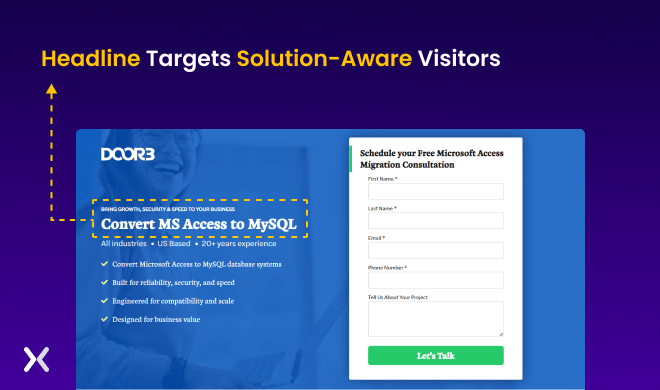
The second landing page targets audiences that are problem-aware. The potential audience understands MS Access’s inefficiencies and are looking for better options. The headline highlights the features problem-aware prospects are looking for and pitches in the services push for landing page conversions.
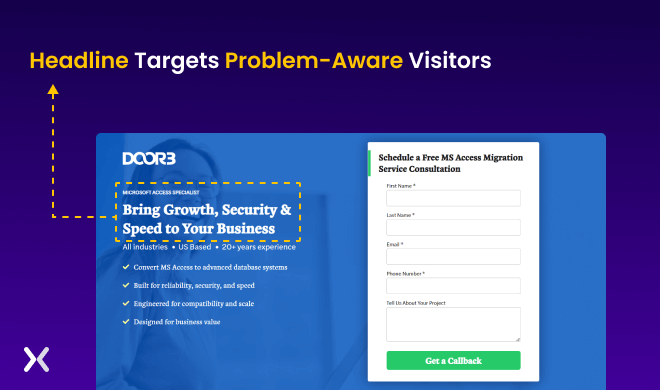
Every marketer knows the importance of landing page A/B testing.
But the question is where to start from.
One place to start is the length of the landing page. A landing page’s length is a UX element that depends on the target audience and is not defined for any industry. While some products might require long-form pages, some services are better off with short-form landing pages.
For example: Here are two insurance landing pages, but both differ in length.
.png)
It is best to start out with a short-form landing page and keep a close eye on user interactions through heatmaps. Through dead clicks and rage clicks on specific elements and words, marketers can identify the content users are looking for and add it to the landing page.
Also, scroll heatmaps can help check the average fold, which refers to the average section visible as the viewer opens the page and no scrolling takes place. It becomes easier to locate the hero section of a page through the average fold and where crucial landing page elements must get placed.
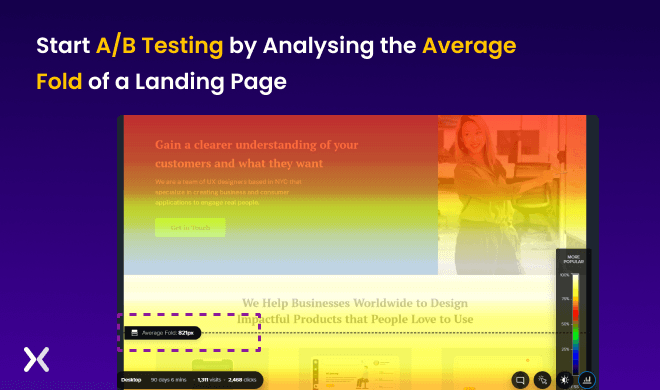
The lead capture form is where the conversion happens. From limited form fields to FOMO in the headline and CTA, all help secure the leads. The form’s placement has always been a debatable topic. Though marketers can put it above the fold, where ready-to-buy leads can come and directly sign-up without wasting any time, it is not ideal for new visitors whose experience might get hindered by it.
So what to do?
The answer is to use heatmaps. Through various hypotheses, trial and error, marketers can surely find the best place to put their form on the landing page. Even if this doesn’t work, brands can use a click-through form that only appears when the CTA is clicked.
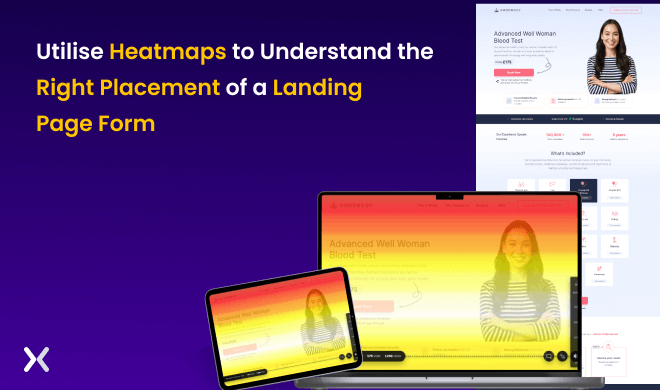
Aiming for high landing page conversions is not enough. The right elements must be in place on the page to achieve goals. Understanding the importance of the value proposition behind a brand makes it easier to create a conversion-driven landing page funnel.
Setting conversion benchmarks based on the targeted industry narrows down the crucial elements a landing page needs. A landing page must combine design and tech elements to create a better user experience.
Need help with landing page conversions? At Apexure, we can help you understand what your page might lack. Contact us today!
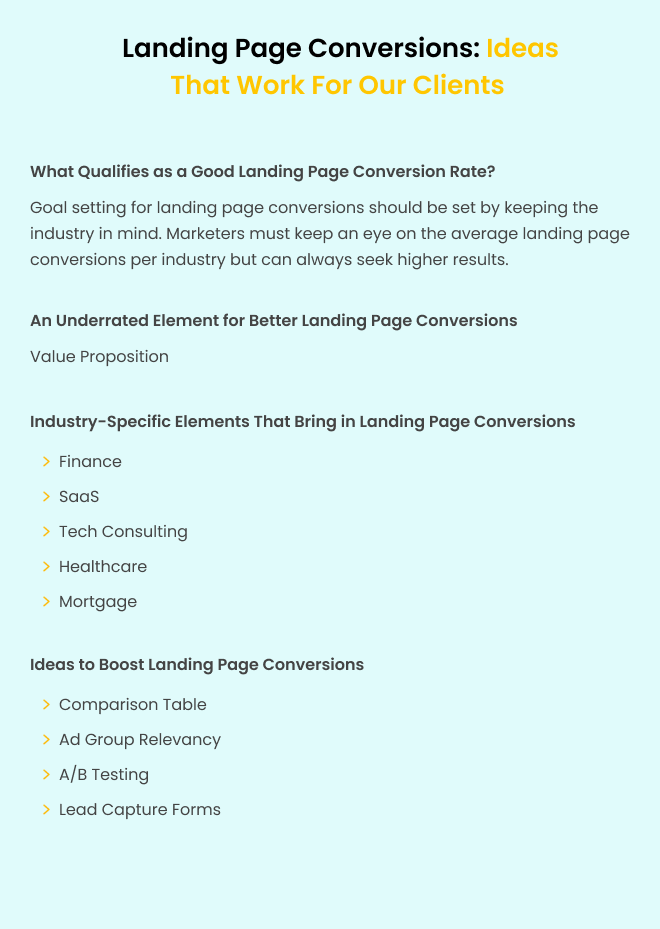
Related Topics:
Drive More Sales or Leads With Conversion Focused Websites and Landing Pages
Get Started
In today’s fast-paced digital world, having a responsive website is no longer just a nice-to-have, it’s essential. Whether...
As artificial intelligence continues to evolve, businesses are finding innovative ways to enhance their marketing efforts. One of...
Get quality posts covering insights into Conversion Rate Optimisation, Landing Pages and great design